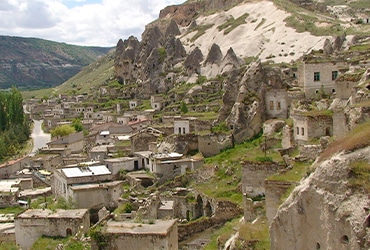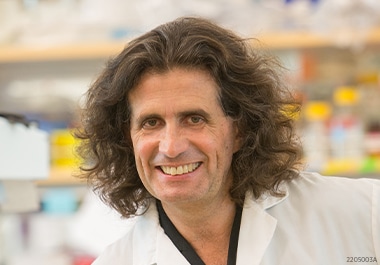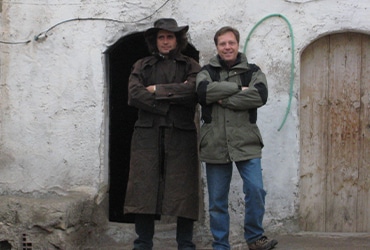Michele Carbone: Gene hunter of Hawai’i
By Richard Lobb
American Association for Cancer Research

In central Turkey lies Cappadocia, a windswept plateau dotted with striking, beehive-shaped rock formations. In centuries past, people dug holes in these rocks and lived in them. Today, villages spread out around the rocks, with houses built with stones from the caves. A few of these dry and dusty villages have been the unlikely setting for an international scientific detective story, funded in part by a grant from AACR.
Michele Carbone, MD, PhD, now at the University of Hawai’i Cancer Center in Honolulu, first came to Cappadocia in 1997. The Italian American pathologist was invited to give a lecture in Ankara on mesothelioma, a subject on which he had developed a reputation while working at the National Cancer Institute. In preparing for the lecture, he read of a fearsome epidemic of malignant mesothelioma that was causing up to half the deaths in some of these villages. The long-running epidemic was reported by Y. Izzettin Baris, his host for the lecture and chair of pulmonology at Hacettepe University. Baris had first visited the villages years before, when the illness was believed to be tuberculosis. He knew right away it was mesothelioma and reported his findings in the 1970s.
“I read about these villages that he had reported in which there was an epidemic of mesothelioma that killed fifty percent of the villagers,” Carbone recalls. “Now there is nothing in cancer that kills fifty percent of the people. This was the most devastating cancer epidemic that has ever been described. “
After the lecture, Baris and his team took Carbone to the villages of Tuzkoy, Karain, and Sarihidir. What he saw and heard astounded him.
“I found a world that I didn’t expect. I found people who wanted to know from me why they had cancer. They told me that I was the expert coming from America, so I would have known why they had cancer, but I didn’t want to tell them because it was a secret. That’s what they thought,” he recalls.
Carbone resolved to help solve the mystery and returned to Tukey several times, using his personal funds and vacation time at first because his institution at that time was reluctant to support the project. Carbone worked closely with Baris and his associate Salih Emri, MD, to try to figure out the epidemic.
Field work
The American and Turkish experts would set up shop in a village, sitting at a table in a courtyard, interviewing the residents, taking chest X-rays with a portable machine, collecting samples, and trying to arrange care for those already ill.
The immediate explanation for the epidemic was the presence of erionite, a fibrous mineral similar to the ones collectively called asbestos. Stones quarried from the rock formations in the villages were rich in erionite. The houses and streets were covered with erionite-containing dust. The villagers could hardly avoid exposure to carcinogenic material.
But there were two confounding factors. For one thing, erionite seemed even more carcinogenic than asbestos. While only about 5 percent of miners who worked in asbestos mines for more than 10 years developed mesothelioma, 50 percent of the villagers developed the disease. In the second place, the epidemic treated different households in the same village differently.
“What I saw there didn’t make any sense,” he says. “The dogma was that the erionite was causing the epidemic, but it didn’t add up, because you had mesothelioma in one household and nothing in the next household even though exposure to erionite was the same.”

It seemed to Carbone that the different impact might be explained by genetics, but untangling the relationships within the villages was a daunting task. Family ties were complex, because the villages were isolated and somewhat inbred; people from villages in the region that didn’t have the mesothelioma problem avoided people from villages that did.
Carbone put together a multidisciplinary team which included Harvey I. Pass, a thoracic surgeon; Haining Yang, a molecular biologist; and Umran Dogan and Ian Steele, mineralogists; and they, together with Drs. Carbone, Baris and Emri, investigated the causes of the cancer epidemic. The team also recruited local people who helped run the field investigation, such as Muamer Tunc, the village tailor in Karain.
“Mr. Tunc’s family had been decimated by mesothelioma, and he eventually developed it himself,” Carbone recalls. “He helped me tremendously in putting together the pedigrees that showed that indeed this was a disease that was transmitted through families.”
“We could not speak the same language,” Carbone recalls, “he only spoke Turkish, but somehow we communicated with hand signs, facial expression, drawings, and the help of children who were learning English in school, and we became best friends.”
Pedigrees pieced together
They eventually pieced together pedigrees which showed that six families affected by the epidemic could be traced back to a common ancestor, a potential “founder effect.”
“The susceptibility to get mesothelioma was transmitted as an autosomal dominant character in some families, which means that the child of an affected parent had a 50/50 chance to inherit the mutation,” Carbone says, and the findings were published in a brief but persuasive report in Lancet in 2001.
Baris initially was skeptical of the genetic hypothesis and did not want to have any part of the research. When Carbone sent him a copy of the paper they had submitted to Lancet, Baris went back to the villages to review the pedigrees for himself. Then he was convinced, and after that he traveled repeatedly back and forth from Ankara to the villages to help find the cause of the cancer epidemic.
“I am old, Carbone,” the Turkish doctor born in 1929 used to say. “I am going to die soon. We have to find the cause and help my people before I die.”
A thorough report was published by AACR’s Cancer Research in 2006. “Pedigree and mineralogical studies indicate that the malignant mesothelioma epidemic is caused by erionite exposure in genetically predisposed individuals,” wrote Carbone, Baris, and co-authors.
Carbone became convinced that these mesothelioma cases resulted from an interaction of the environment with a specific gene. But what gene? And where was it located? The questions consumed Carbone for several years.
Carbone applied for and received the 2008 Landon Foundation-AACR Innovator Award for International Collaborations in Cancer Research to further his work in Cappadocia.
“The award was critical for the type of research that I do, because it is outside the known, and there are no mechanisms that are easy to use to fund research in a third-world setting,” he says. “Grants like these are critical because they allowed me to organize teams to go in the villages to conduct research and pay for this critical fieldwork that otherwise would have been impossible to fund through a regular grant.” He had also received a National Cancer Institute P01 grant of $10 million to help find the elusive gene. The grant covered the cost of the experiments in his laboratory and that of his collaborators.
What are the odds?
It was clear that the gene conveyed a predisposition to other cancers beyond mesothelioma. In addition to the research in Turkey, Carbone was tracking two families in the United States with an unusual amount of mesothelioma. When a member of one family who had mesothelioma was also diagnosed with uveal melanoma, the second such case in that family, Carbone knew this could hardly be a matter of chance. He asked a colleague, statistician Ian Pagano, to calculate the odds of these two rare cancers occurring in the same person, in a family with multiple cases of mesothelioma. The answer was that the chances might be two in ten million.
Carbone picked up an oncology textbook and looked up uveal melanoma. It said mutations and deletions on chromosome 3p were common. Based on genetic linkage analyses, 3p was one of several chromosomal regions in which Carbone and colleagues already suspected that the mesothelioma gene could reside. At last, he had a clue, and just in time.
“We were for four years and six months into a five-year $10 million dollar grant, and we had published nothing, absolutely nothing,” he recalls. “We had sequenced miles of DNA in my lab in Hawaii and we had found nothing.”
Those were the days before next-generation sequencing, and hunting for genes was very time-consuming. There were no robots, and all sequencing had to be done by hand. Carbone told his team to drop everything else and focus on chromosome 3p. And there it was – the BAP1 gene, loaded with mutations.
Various analyses strengthened the case that mutated BAP1 was the culprit. Critically, DNA sequencing showed that all affected members of the two U.S. families had BAP1 mutations, while none of the non-affected family members had inherited them.
Carbone eventually identified many more U.S. families with the mesothelioma predisposition. In 2019, the National Cancer Institute opened two clinical trials based at its headquarters in Bethesda, Maryland, for patients and family members carrying BAP1 mutations. The pedigree of one of these families includes about 80,000 people, among them Harry S. Truman, president of the United States from 1945 to 1953, who luckily did not inherit the mutated gene. This extended family’s roots in America go back to 1717 and in Europe back to the 1400s.

While the hunt for the gene was going on, Carbone and his team, together with scientists of the Environmental Protection Agency led by Aubrey Miller, investigated whether the presence of erionite in the western United States might pose a threat to public health if the mineral was disturbed by urban development or mining operations. Their attention focused on Dunn County, North Dakota, where they discovered that gravel containing erionite was used to pave rural roads, so that fibers could be kicked into the air by traffic. In a study funded in part by the AACR grant, their measurements showed that exposure intensity in vehicles driving on roads, including school buses, can equal or exceed the levels they found in the dusty streets of the villages in Turkey. In response, the state of North Dakota banned the use of gravel from sources known to contain erionite.
The physical results of Carbone’s work were more dramatic in Turkey. Baris had tried for years to get the Turkish authorities at least to get people away from the erionite by relocating the villages, but he had no luck. On one of his trips, Carbone had dinner with Baris and his team, who bemoaned the government’s failure to act. A waiter overheard them and offered to call his cousin who worked at the ministry of health and ask him to set up a meeting. The cousin obliged, and in a week, Carbone, Baris, Emri, and Dogan were on their way to meet the minister.
“It is better if you talk, because you are an American and maybe he will listen to you,” Baris told Carbone at the very last minute, as they sat in front of the minister. Carbone gave the minister a briefing while Baris translated. The minister listened politely but did not say much.
New villages
A year later, on his next trip to the country, Carbone was delighted to find that the minister had taken him seriously. Carbone learned that Dr. Murat Tuncer, then the Director of Cancer Control at the Turkish Ministry of Health, had taken a keen personal interest in the project to ensure the villagers were promptly relocated to new homes that were built nearby, free of erionite. Dr. Tuncer’s deputy took Carbone to see the first of the new villages, Tuzkoy, with modern homes of brick and cement, with electricity, appliances, and indoor plumbing, quite a change from the old villages.
The new villages also have a clinic where residents can be checked for the earliest signs of onset of the disease and treatment started. The gene isn’t going away, but at least people are shielded from the worse of the environmental contamination and they know what to look for in their health status.
Carbone’s work in Turkey earned high praise from Turkish colleagues. Emri, right-hand man to Baris during the investigation, wrote in the Annals of Translational Medicine:
“When we joined forces with Dr. Carbone we made terrific progress, largely because of the enthusiasm he brought to the team with his collaborative approach, determination, drive, and ability to keep an open mind.”
The last time Carbone visited the villages was in July 2019. Mr. Tunc, the tailor, had developed mesothelioma and sent a message to Carbone that he would like to see him before he died. Two weeks later, Carbone flew to Turkey and drove with Emri to the villages.
“Mr. Tunc was pale and frail, but his eyes were happy as he showed me his beautiful new home, the garden where he grew vegetables,” Carbone says. “He told me, ‘it is fine, I always knew one day it would get me, but I am one of the last ones’.”
“We did it!” the tailor said. “The kids of my village, the kids of my kids, no longer grow up in houses made of erionite. There will be no more cancer in the village.”
Carbone recalls that Baris had told him the same thing before he died.
“I hope they are right, and that removing erionite will be enough,” Carbone says. “At least it should decrease the size of the problem. Our science helped, but if the villagers have new homes and a clinic where they can be treated without having to drive far away, that is largely thanks to the Turkish Ministry of Health and to Dr. Murat Tuncer in particular.”
Carbone first traveled to Turkey in 1997, published his first findings in 2001, and announced evidence of the gene-environment interaction in 2011. The long but successful investigation of the mesothelioma investigation in Turkey needed funding from the AACR, the NCI, and others, but he says the science came first.
“The money followed our discoveries,” he says. “I didn’t go for the money. Nobody thought the NIH would give me a grant of $10 million to study mesothelioma in Cappadocia. I got it. But I was not looking for it. It just followed.”
Asked what advice he would give to younger investigators, Carbone said: “Do something that you want to do and for which you have passion, because if you have your passion, it is worthwhile doing. Chances are, that because you have the passion for it, you will find a way to make things work.”
“And don’t listen to all the people who will tell you it’s impossible,” he adds. “Because if you listen all day to people who tell you it is impossible, you will never do anything.”
For further reading:
Lancet 2001
Iman Roushdy-Hammady, Jennifer Siegel, Salih Emri, Joseph R. Testa, Michele Carbone. Genetic-susceptibility factor and malignant mesothelioma in the Cappadocian region of Turkey. Lancet. 2001 Feb 10;357(9254):444-5. doi: 10.1016/S0140-6736(00)04013-7
Cancer Research 2006
Dogan AU, Baris YI, Dogan M, et al. Genetic Predisposition to Fiber Carcinogenesis Causes a mesothelioma Epidemic in Turkey. Cancer Res. 2006; 66:5063-8. doi: 10.1158/0008-5472.CAN-05-4642
Nature Reviews Cancer 2007
Carbone M, et al. A mesothelioma epidemic in Cappadocia: scientific developments and unexpected social outcomes. Nat. Rev. Cancer. 2007;7:147–154. doi: 10.1038/nrc2068
PNAS 2011
Carbone M, Baris YI, Bertino P, et al. Erionite exposure in North Dakota and Turkish villages with mesothelioma. Proc Natl Acad Sci USA. 2011;108:13618-23. doi: 10.1073/pnas.1105887108
Nature Genetics 2011
Testa JR, Cheung M, Pei J, Below JE, Tan Y, Sementino E, Cox NJ, Dogan AU, Pass HI, Trusa S, Hesdorffer M, Nasu M, Powers A, Rivera Z, Comertpay S, Tanji M, Gaudino G, Yang H, Carbone M. Germline BAP1 mutations predispose to malignant mesothelioma. Nat Genet. 2011 Aug 28;43(10):1022-5. doi: 10.1038/ng.912.
Annals of Translational Medicine 2017
Emri SA. The Cappadocia mesothelioma epidemic: its influence in Turkey and abroad. Ann Transl Med. 2017 Jun;5(11):239. doi: 10.21037/atm.2017.04.06.
Nature 2017
Bononi A, Giorgi C, Patergnani S, Larson D, Verbruggen K, Tanji M, Pellegrini L, Signorato V, Olivetto F, Pastorino S, Nasu M, Napolitano A, Gaudino G, Morris ,Sakamoto G, Ferris LK, Danese A, Raimondi A, Tacchetti C, Kuchay S, Pass HI, Affar EB, Yang H, Pinto0n P, Carbone M. Nature (2017). BAP1 regulates IP3R3-mediated Ca2+ flux to mitochondria suppressing cell transformation. 546:549-553. doi: 10.1038/nature22798.
CA: A Cancer Journal for Clinicians 2019
Carbone M, Adusumilli PS, Alexander HR, Baas P, Bardelli F, Bononi A, Bueno R, Felley-Bosco E, Galateau-Salle F, Jablons D, Mansfield AS, Minaai M, de Perrot M, Pesavento P; Rusch V, Severson DT, Taioli E, Tsao A, Woodard G, Yang H, Zauderer MG, Pass HI. (2019). Mesothelioma: Scientific Clues for Prevention, Diagnosis, and Therapy. CA Cancer J Clin. 2019 Sep;69(5):402-429. doi: 10.3322/caac.21572.
Nature Reviews Cancer 2020
Carbone M, Arron ST, Beutler B, Bononi A, Cavenee W, Cleaver JE, Croce CM, D’Andrea A, Foulkes WD, Gaudino G, Groden JL, Henske EP, Hickson ID, Hwang PM, Kolodner RD, Mak TW, Malkin D, Monnat RJ Jr, Novelli F, Pass HI, Petrini JH, Schmidt LS, Yang H. (2020). Tumor predisposition and cancer syndromes as models to study gene X environment interactions. Nat Rev Cancer. 2020:533-549, (Perspective). doi: 10.1038/s41568-020-0265-y.
Cancer Discovery 2020
Carbone M, Harbour JW, Brugarolas J, Bononi A, Pagano I, Dey A, Krausz T, Pass HI, Yang H, Gaudino G. (2020). Biological mechanisms and clinical significance of BAP1 mutations in human cancer. Cancer Discovery. 2020: 10:1103-1120, doi: 10.1158/2159-8290.CD-19-1220.